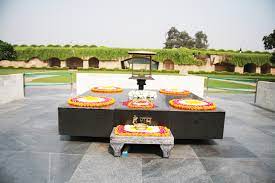Raj Ghat which also means ‘King’s Court’ is located on the banks of the Holy Yamuna River on Mahatma Gandhi Ring Road in Delhi officially named after the ‘Father of the Nation’, Mahatma Gandhi Ji who was also one of India’s greatest Leaders and freedom fighters who believed that Independence can be achieved by non violence and simple methods like fasting to death, which contrasted with many other Freedom Fighters who believed more in bloodshed and battles.
Mahatma Gandhi Ji was probably one of the greatest and undisputed leaders well respected by everyone. He led the way of ‘non-violence’ and ‘righteous path’ in order to force the British to Quit India. He also actively participated in many freedom movements including the Quit India Movement and was always in the forefront of it as its leader sincerely trying hard for the Independence of India and hence, ‘Father of the Nation’ is a well deserved name given to him.
Raj Ghat is where Mahatma Gandhi Ji was cremated on 31st January 1948 after his assassination and his ashes were buried and hence make it his final resting place beside the sanctity of the Yamuna River. It is constructed in the shape of a large square platform laid with black marble and an eternal flame burning perpetually in one corner to symbolising the eternity of this great leader. It is flanked with pathways made of stone stringed through the green covered lawns to arrive at the walled platform of this Memorial Site.
Raj Ghat was designed by an architect named Vanu G. Bhuta reflecting the simplicity of the life of Mahatma Gandhi Ji which also won the India Invitational Competition held by the Government of India due to the very fact that it depicts the black marbled flat platform surrounded by red coloured earth as seen around the small ashrams of Gandhi Ji built like simple huts without the existence of English style lawns or gardens. All major dignitaries of the world make it a necessity to visit this Memorial of Mahatma Gandhi Ji at Raj Ghat in order to pay their respect and homage to this undisputed leader by putting reeds of flowers and garlands on this platform.
The Raj Ghat Memorial has seen many changes in design keeping its originality and simplicity in mind including a few additions on the request of Jawaharlal Nehru, India’s first Prime Minister Post Independence. An epitaph ‘Hey Ram’ is also seen inscribed on the Memorial which means ‘O Ram’ or ‘O God’ which were the last words uttered by Gandhi Ji after he was shot by Nathuram Godse and died in the arms of his followers.
It is essential to know for all visiting this Memorial ground to ensure that you remove your shoes or footwear before entering the actual Memorial Site as a sign of respect to Gandhi Ji. Every Friday, you can attend a commemorative ceremony dedicated to Mahatma Gandhi Ji and also visit the prayer sessions organised on his birthday on 2nd October and during his death anniversary every year. You can also visit the two Museums including the National Gandhi Museum, dedicated to the life and works of Mahatma Gandhi Ji and the Nehru-Gandhi family.
Cremation sites also known as ‘Samadhi’ in Hindi Language of many famous political leaders can be seen in the proximity of Raj Ghat along the banks of the Yamuna River. The landscapes of all these memorials were designed by Sydney Percy Lancaster who was the Secretary of the Agricultural and Horticultural Society of India and also the last British to serve as the Superintendent of Horticulture Operations in the Indian Government.
Raj Ghat can be visited on all days and from morning up till evening preferably between 1000 hours to 1700 hours and one is allowed can carry garlands and flowers to put on Mahatma Gandhi Ji’s Memorial Platform as a sign of respect. It is easily accessible by local taxis and auto rickshaws.
- Guardians of the Game: The Critical Role and Unwavering Necessity of Fraud Verification Companies in Korea’s Toto Ecosystem - February 20, 2024
- Discover These Top Scenic Treks near Delhi - January 31, 2024
- Delhi Travel Tips - June 22, 2021

